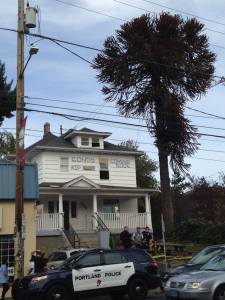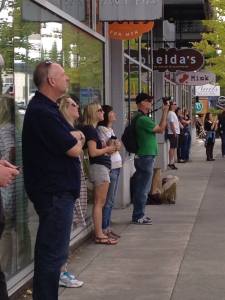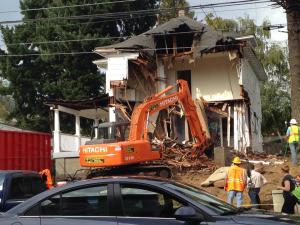Blog Archives
Some high- and lowlights from the 3425 SE Hawthorne demolition, Oct 15th and 16th, 2015
Top left: Day 1 of demolition. At this point, a protester was on the roof, having climbed the Monkey Puzzle Tree, and the crew went around back and pulled the back porch off just to make a point (and possibly so the crew would actually get paid for something).
Top right: Day 1 of demolition, across the street. The woman in white and blue stripes with blonde hair was extremely entertained, asking others near her if Oregon often has protests over home demolitions. She said she was from out of state and then expressed happiness that she could have “lunch and a show”. I told her that was a terrible thing to say. She did not enjoy hearing that.
Bottom right: Day 2 of demolition, taking the front of the house. By this point the back wall house is gone, they’ve been smashing windows. I saw no evidence of salvage. As far as I know, all this debris went to a landfill. They filled the red truck with debris by 2:45 PM.
One blogger sets us straight about tossing that g-word around.
I’m not actually sure what I just read. I think I just read the blog post of someone who got paid to tell me I don’t know the underlying issues contributing to gentrification, and while I’m no urban planner, I think I kind of do!
The deeper problems we miss when we attack ‘gentrification’
While not directly an infill issue, this is a driver to clearing the space to then pack “infill” onto.
I sure would like to see a city where they’re doing what this blogger says brings jobs into historically-poor neighborhoods, yet doesn’t displace long-time residents. Is that possible? Because in Portland, outside investment in historically neglected neighborhoods does bring grocery stores, but recently, those are along the lines of Trader Joe’s and Whole Foods and New Seasons, none of which are affordable relative to the area and not even for people like me. They may employe some long-time residents hanging on for dear life, but that doesn’t mean they can shop there. The blogger also complains that it’s good if a sit-down restaurant moves in where a vacant storefront was, but isn’t that ignoring that maybe the storefront is vacant because the neighborhood businesses were not supported and had to close? How about an effort to bring those businesses back, or can the blogger acknowledge that the pricing-out of people fundamentally changes neighborhoods in such a way that businesses move to less expensive areas and the die is cast? That sure has happened in Portland.
Tanzamook: It’s like pink ribbons, but for high density* infill development.
It’s like pink ribbons, but for high density infill development.
Granted, that is also a wobbly comparison, but it has NPR practically oozing from its seams or pores, however you want to picture the beast that is infill. This is how I’m parsing it. So.
Irvington, despite being called a historic neighborhood (I know Irvington is not terribly uniform as such; bear with me), is not protected against incremental deposits of new construction in keeping with the Portland Plan. This is much to the surprise and chagrin of some. As such, newer developments have already happened in Irvington, including the development of housing at NE 11th and NE Tillamook. Said development is lauded in a couple of articles I’ve read as being quite virtuous: Efficient, wired for the future, and socially sustainable.
What’s that?
Apparently, within the context of the 11th and Tillamook development, aka “Tanzamook”, a portion of the proceeds of sales of said units will go to help schoolchildren in Tanzania, ostensibly by funding the construction of dormitories for schoolchildren, possibly girls.
So if you buy a unit at 11th and Tillamook, think less of it as living in a totally un-period and aesthetically dubious pocket of Irvington and more of it as doing a…do-good thing.
The obvious problem is, to me, that this is at least a little bit obfuscate-y, considering that the real issue is exploiting loopholes to develop against the character of the neighborhood, no matter how much you say you worked with your (immediate) neighbors. Add to this the idea that a socially-responsible project to help people against significant obstacles halfway around the world seems slightly misplaced when the impacts and reverberations of decades of systematic redlining, discriminatory lending, and outright displacement happened almost next door to such a development. I can’t tell the developer and the architect to stop having an emotional connection to Tanzania, but maybe…look closer to home if you really want to do socially-conscious development. Repeatedly, I’ve read about a wish to re-settle Albina with some displaced black residents. How about that?
The Tanzamook story is already six or seven years old, so why bring it up now? Because as we’ve seen in the interim, these developments are becoming more numerous. As we also saw with the trouncing of the proposed Trader Joe’s in NE PDX, there was a pushback from the black community then and also with the subsequent development of Natural Grocers, which would provide fresh groceries at affordable prices (food desert problem solution?), but would possibly not use the land to re-settle displaced individuals.
There are plenty of vacant lots in NE PDX where the damage to the look of the neighborhood is done. There are plenty of people needing good housing minus exclusionary prices. Sounds like a good opportunity for developers and locals to me, but what does one blogging complainer know?
NOTE: This was written when I knew a lot less about the infill situation in Portland.
Airbnb: Yet another threat to affordable rents in the city of roses, bridges and stumps
I never considered this before, but it has come to my attention that it’s already practice to (illegally) rent out apartments to Airbnb clients.
Well great. And Portland is apparently welcoming such business with open arms.
http://www.wweek.com/portland/article-22785-city_for_rent.html
Inclusionary development as a terrible millstone? According to this Oregonian op ed, anyway.
This is fresh. As of *today*. This runs counter to most things I assume to be true about inclusionary zoning, and it’s so new I’m still reading it, but it seems to like to play devil’s advocate.
Having said that, I have read that even the definition of “affordable” can be arbitrary when the topic of affordable housing comes up, and I have also seen in some documentaries and read in recent articles that the reaction to mixing social strata in close proximity is discomfort and resentment. Make of that what you will.
http://www.oregonlive.com/opinion/index.ssf/2015/05/builders_are_right_to_fear_inc.html#incart_river
Too little too late? City of Portland just now considering how it manages infill development?
Very recent development. Does the study equal a moratorium? Judge for yourself. http://www.oregonlive.com/business/index.ssf/2015/04/portland_considers_downsizing.html#incart_2box
Imbalance of power, retro edition: Urban renewal in SW Washington, D.C.
Trying to get a better idea of what mid-century people were thinking, pushing forward with urban renewal projects that demolished thousands houses and displaced hundreds of thousands of low-income people, I’ve been watching documentaries online. Today’s documentary goes a little bit into what happens when an area is declared a slum and cleared, when promises to the displaced are broken. Whether it’s clearing a neighborhood for a freeway, a mall, an arena, or bulldozing individual houses so you can pack as many people in as possible, the power is never with the individuals, and for some reason governments are too inefficient to help. This pains me to say; I would love to see helpful and effective government agencies, but they are often conspicuously absent from these stories.


